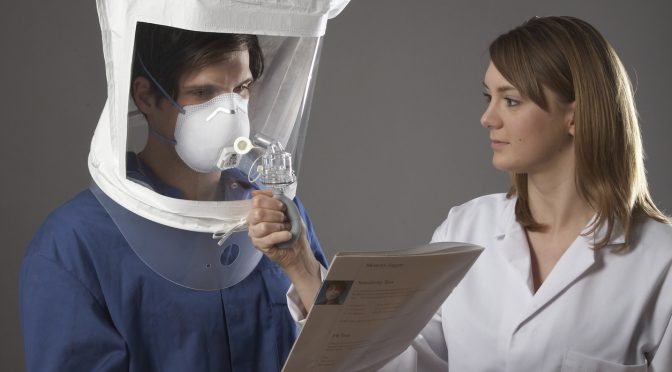
MAKE AN APPOINTMENT TO SCHEDULE YOUR RESPIRATOR FIT TEST AND MEDICAL EVALUATION TODAY
Qualitative and Quantitative Fit Testing
Respirator fit testing is performed to determine if an employee has an acceptable respiratory fit and can maintain a sufficient seal. OSHA CFR 29.134 states that Respirator Fit Testing must be done prior to use, whenever a different respirator is worn, and at least annually thereafter. Fit testing will be administered using an OSHA-accepted qualitative fit test or quantitative fit test protocol and the employee must be tested with the same make, model, style, and size of respirator that will be used on the job.
When to fit test
- After subject is medically cleared for respirator use
- Before the subject wears the respirator in the workplace
- Facial changes
- Significant weight change
- Change of respirator size, make, model
- Whenever employee reports a problem with fit *The OSHA requirement for annual fit testing of respirators in healthcare settings is currently under review.
Qualitative
OSHA recognizes four types of Qualitative Fit Testing: Bitrex™ solution aerosol, saccharin solution aerosol, isoamyl acetate (banana oil) and irritant smoke (stannic chloride).
- A subjective pass/fail test to assess the adequacy of respirator fit.
- Relies on the individual's response to the test agent.
- No eating, drinking (water is allowed), gum or smoking for 15 minutes prior to test.
Sensitivity test procedure:
- Subject is placed in hood without respirator
- Subject should open mouth and extend tongue
- Subject should breathe through mouth
- Apply 10 bulb squeezes of testing solution into the hood
- DO NOT spray testing solution into the subject’s face
- If subject does not taste fit test solution in 10 squeezes, apply another 10 squeezes
- If subject can’t taste solution by 30 squeezes, use another fit testing solution
Quantitative
OSHA recognizes three types of Quantitative Fit Testing: Generated aerosol, ambient aerosol nuclei count (CNC) and controlled negative pressure (CNP).
All three types of quantitative fit testing use a digital instrument that measures airborne particles inside and outside the test respirator or measures vacuum pressure. A special sampling probe takes measurements inside the mask.
- Generated aerosol uses an aerosol, typically corn oil, that is dispensed in a high concentration into a booth or test chamber and a photometer based aerosol detector that measures the challenge agent that leaks into the face piece. This type of quantitative fit testing is the least used of the three types due to the large size of the unit and the high maintenance involved in cleaning the booth and the components.
- Ambient aerosol condensation nuclei counting (CNC) instruments, such as the TSI brand Portacount, use laser technology to measure aerosol concentrations inside and outside the respirator without the person having to stand in a test chamber or booth. The challenge agent measured consists of ambient microscopic dusts and aerosol particles that are in the air we breathe every day. The particle concentration outside the respirator is measured against the concentration inside the respirator, and the ratio of those two numbers is the fit factor. This system typically tests a P100 (HEPA) filter. However, the TSI Portacount has an N95 companion, which is used to fit test 95 filter-class respirators, such as N95 disposable filtering face-piece respirators.
- Controlled negative pressure (CNP) systems, such as the Occupational Health Dynamics (OHD) Fit Tester, creates a fixed vacuum on the face piece by temporarily cutting off the breathing air with special adapters. The instrument measures the airflow, or leak rate, needed to maintain the vacuum on the mask. The fit factor is then computed by taking an average breathing rate and dividing that number by the measured leak rate. The person being fit tested must remain motionless for the 10 seconds needed to conduct the test. OSHA also requires CNP fit testing to include its REDON protocol. This protocol includes exercises performed facing forward and bending over, shaking the head and two redonnings of the respirator face piece.
All three OSHA-accepted quantitative fit tests require the face piece being tested to be equipped with high-efficiency particle filters (P100/HEPA) so that no particles enter the respirator and skew the results. The mask is also equipped with a temporary probe adapter or the person being tested might wear a surrogate mask with a permanent sampling probe.
Also, all three tests use these eight 60-second exercises:
- Normal breathing
- Deep breathing
- Turning head side to side
- Lifting head up and down
- Talking out loud
- Grimacing (15 seconds)
- Bending and touching toes (or jogging in place)
- Normal breathing
Not only does OSHA require fit testing, but it is a crucial step in the verification of respirator selection and proper respirator usage. Quantitative fit testing is commonly used in applications were higher fit factors are required. Quantitative fit testing equipment is also expensive, so many companies will contract with an industrial hygienist or other professional, or possibly rent the instrument and perform the test themselves.
What we do for Quantitative Fit Testing?
ASC utilizes the Gold Standard in Respirator Fit Testing, the OHD Quantifit® which is completely portable. The patented controlled negative pressure technology is used to run a complete 5-step protocol in 3 minutes or less. This is not only the fastest, but also the most accurate way to conduct a quantitative respirator fit test.

